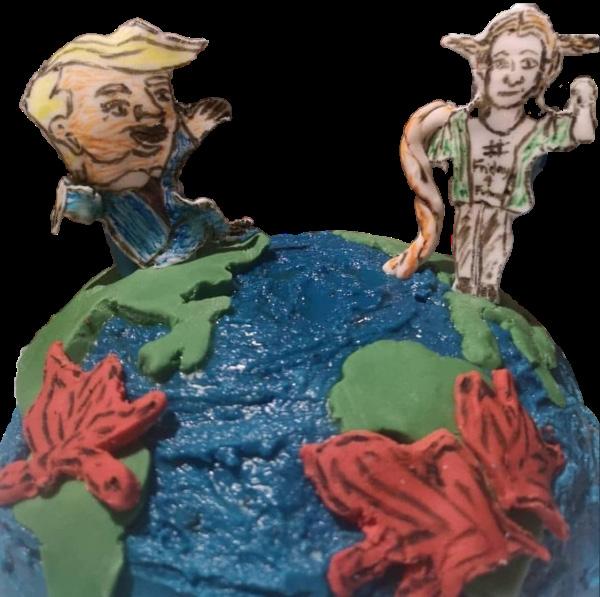
4 minute read
The Portrayal of Heroes & Villains in the Media
Scarlett Parr-Reid discusses whether the media should be allowed to typecast superheroes and cartoon villains in their narratives.
From the portrayal of heroes such as Harry Potter, Matilda Wormwood and Jo March, to villains like Cruella de Vil, Bill Sikes and Count Olaf, the narratives of storybooks guide our viewpoints. Is this same bipolarity of ‘goodies’ and ‘baddies’ seen in the media? Take, for example, coverage of climate change. Can we really say that Greta Thunberg is a hero and politicians are villains? Reality is far less simple and is inherently nuanced. Case in point, Channel 4’s Climate Debate of November 2019. Five of seven party leaders stood poised at their podiums, two replaced with ice statues melting as the show continued. Boris Johnson was absent, but afterwards stated that he “can’t do absolutely everything…the media process demands”, and maintained it was achievable to “reach net zero carbon emissions by 2050”. The same media process led to “more people…talking about [the ice statues] than any of the substance that came out of the debate..[which is] a shame”, as Johnson put it. Perhaps in its perceived narrative of mockery and trivialisation, Channel 4 is no less of a baddie than a Prime Minister who, as LBC stated, “didn’t show up”.
Advertisement
Rewind to December 5, 2016: the world’s first declaration of a climate emergency was signed by Australian Greens Councillor, Trent McCarthy in Darebin, Melbourne. This was an historic move, but fast forward to September 2019, the beginning of the worst bushfire
season in Australia since 1974: temperatures peaked at 40.9 degrees celsius and droughts ravaged the land. Since the fires began, 18.6 million hectares of land have been scorched, 29 people and nearly one billion animals have died, with some species perhapsdriven to extinction. All the while, Australian President Scott Morrison holidayed in Hawaii, saying on his return that the emergency response to the bushfires was “the best in the world”. Morrison went on to say that associating the bushfires and climate change was “not a credible link”. This new form of denialism, akin to Trump’s relaxation of restrictions on power plant emissions, is obstructive and represents power politics over morality. Moreover, Morrison describes “the urge to panic [as] politically motivated” – a nod to Swedish climate activist Greta Thunberg’s words “I want you to panic” at the World Economic Forum in Davos.

Thunberg aligns panic with moral duty and responsibility. To what extent does anger achieve action? To play devil’s advocate. If your teenager said, “How dare you? You have stolen my dreams and my childhood”, how might you respond? There are ways of saying things without a tone of resentment and vexation; however, Thunberg’s anger signals the need for decision. It’s the boiling over of frustration, and we should be frustrated about inaction. When a contributor to Fox news referred to Thunberg as “exploited by her parents and the international left”, they really meant that she is not a climatechange denier and does not subscribe to “fairy tales of eternal economic growth”. After her speech at the 2019 UN Summit, Thunberg called for action on the climate crisis from five countries – Germany, France, Brazil, Argentina and Turkey – but stopped short of China. China is not a democracy. But she emphasised that “the real power belongs to the people”, offering hope that there will be a knock-on effect in China if the democracies take action first. The reality, as Sir David Attenborough put it, is if the Chinese were to state that “for our own reasons we are going to take major steps to curb our carbon output because our climate is changing… everybody else would fall into line”.
In essence, typecast superheroes and cartoon villains are an easy narrative for the media. In reality, it’s not with ease that the world emerges from a climate crisis. The media should be impartial - showing and not telling. Right now, we have the option to sit back and let the ‘heroes’ and ‘villains’ struggle and occasionally check our devices to see who is winning. Australian opposition Labour leader Anthony Albanese made a pertinent comment on the Climate issue: “Here’s the contradiction in the Government’s position – they say Australia produces just 1.3% of emissions therefore [they] don’t have a responsibility to act, it really won’t make a difference”. Truthfully, he said, “if everyone says that, of course, no-one will act”. The portrayal of heroes and villains by the media only perpetuates this inaction through disenchantment of the public with politicians.
Dichotomous thinking will leave us wanting.
See, for example, this year’s Nobel Peace Prize nominations, a list on which both Donald Trump and Greta Thunberg appear. Headlines sell ideas in the attention economy. One Guardian headline quotes Trump as ‘reckless’ and another quotes Thunberg as a ‘warrior’. Perhaps it’s time to move on from identity politics and personality contests towards a balanced and humane analysis in the media. As Krystal D’Costa of the Scientific American puts it, the news media leave us “free to choose those [beliefs] that relate best to us” and the narratives that align with our cultural identities. These people are humans, not cartoon characters.
artwork: scarlett Parr-Reid










